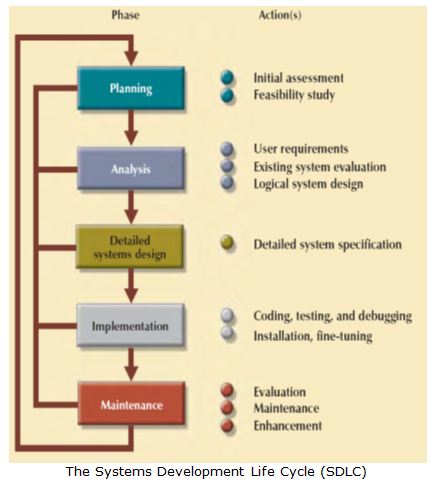Systems Development Life Cycle (SDLC)
The Systems Development Life Cycle (SDLC) traces the history (life cycle) of an information system. Perhaps more important to the system designer, the SDLC provides the big picture within which the database design and application development can be mapped out and evaluated.
The traditional SDLC is divided into five phases: planning, analysis, detailed systems design, implementation, and maintenance. The SDLC is an iterative rather than a sequential process. For example, the details of the feasibility study might help refine the initial assessment, and the details discovered during the user requirements portion of the SDLC might help refine the feasibility study.
The Systems Development Life Cycle (SDLC)
Because the Database Life Cycle (DBLC) fits into and resembles the Systems Development Life Cycle (SDLC), a brief description of the SDLC stages is as follows.
1. Planning:
The SDLC planning phase yields a general overview of the company and its objectives. An initial assessment of the information flow-and-extent requirements must be made during this discovery portion of the SDLC. Such an assessment should answer some important questions:
• Should the existing system be continued? If the information generator does its job well, there is no point in modifying or replacing it.
• Should the existing system be modified? If the initial assessment indicates deficiencies in the extent and flow of the information, minor (or even major) modifications might be in order. When considering modifications, the participants in the initial assessment must keep in mind the distinction between wants and needs.
• Should the existing system be replaced? The initial assessment might indicate that the current system’s flaws are beyond fixing. Given the effort required to create a new system, a careful distinction between wants and needs is perhaps even more important in this case than it is when modifying the system.
Participants in the SDLC’s initial assessment must begin to study and evaluate alternative solutions. If it is decided that a new system is necessary, the next question is whether it is feasible. The feasibility study like The technical aspects of hardware and software requirements, The system cost, The operational cost must be evaluated.
2. Analysis:
Problems defined during the planning phase are examined in greater detail during the analysis phase. A macro analysis must be made of both individual needs and organizational needs, addressing questions such as:
• What are the requirements of the current system’s end users?
• Do those requirements fit into the overall information requirements?
The analysis phase of the SDLC is, in effect, a thorough audit of user requirements.
The existing hardware and software systems are also studied during the analysis phase. The result of analysis should be a better understanding of the system’s functional areas, actual and potential problems, and opportunities. End users and the system designer(s) must work together to identify processes and to uncover potential problem areas. Such cooperation is vital to defining the appropriate performance objectives by which the new system can be judged.
The analysis phase also includes the creation of a logical systems design. The logical design must specify the appropriate conceptual data model, inputs, processes, and expected output requirements.
3. Detailed Systems Design
In the detailed systems design phase, the designer completes the design of the system’s processes. The design includes all the necessary technical specifications for the screens, menus, reports, and other devices that might be used to help make the system a more efficient information generator. The steps are laid out for conversion from the old to the new system. Training principles and methodologies are also planned and must be submitted for management’s approval.
4. Implementation:
During the implementation phase, the hardware, DBMS software, and application programs are installed, and the database design is implemented. During the initial stages of the implementation phase, the system enters into a cycle of coding, testing, and debugging until it is ready to be delivered. The actual database is created, and the system is customized by the creation of tables and views, user authorizations, and so on.
The database contents might be loaded interactively or in batch mode, using a variety of methods and devices:
• Customized user programs.
• Database interface programs.
• Conversion programs that import the data from a different file structure, using batch programs, a database utility, or both.
5. Maintenance:
Almost as soon as the system is operational, end users begin to request changes in it. Those changes generate system maintenance activities, which can be grouped into three types:
• Corrective maintenance in response to systems errors.
• Adaptive maintenance due to changes in the business environment.
• Perfective maintenance to enhance the system.
Because every request for structural change requires retracing the SDLC steps, the system is, in a sense, always at some stage of the SDLC.
You May Also Like:
Database Development Life Cycle
Conceptual Design in Database Design Process
Logical Design
Physical Design
Database Design Strategies
Back to DBMS Questions


